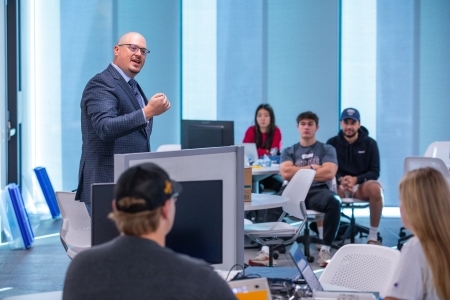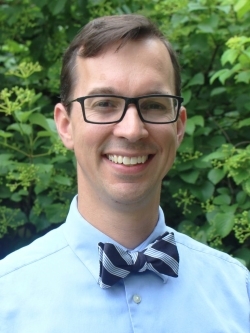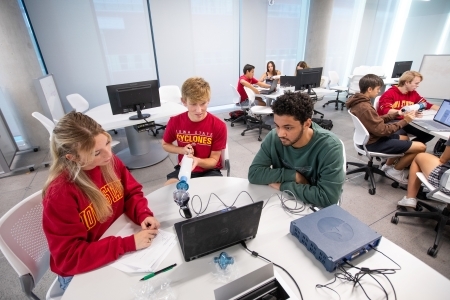AMES, Iowa – Some 50 students, split between two consecutive sessions, recently filed in to a second-floor classroom in Iowa State’s Student Innovation Center, settling at eight stations in groups of threes and fours.
These were the first students, most of them first-semester freshmen, to sign up for Iowa State’s new major in biomedical engineering. And this session of introductory BME 160 was going to be a lab day.
The students’ task: collecting data and crunching numbers about each other’s lung capacity.
“We’re talking about flow, right?” said Thomas Mansell, an associate professor of chemical and biological engineering, the Karen and Dennis Vaughn Faculty Fellow and the course instructor.
He explained the electronic equipment in front of each group included a transducer – “a flow meter. It converts the flow rate of air into current. That allows us to measure your breath and see your lung capacity.”
Before the groups started the project by carefully calibrating their tools, Mansell said a lab about flow rates in a traditional engineering course probably wouldn’t measure lung capacity. But this is a new kind of course.
“This course is really an engineering problem-solving course with a biomedical veneer,” he said.
So, there was Majid Shahwan, a sophomore from Detroit, breathing into the transducer. First normal breaths. Then maximum inhale and maximum exhale. Followed by more normal breathing.
Shahwan’s lab partners – freshmen Jack Moore from Des Moines and Yewon Shin from Seoul, South Korea – watched a laptop as the machine recorded the flow rate with a trace on a graph moving up and down, the peaks and valleys rounded and smooth.
All three, after completing the program’s foundation courses this academic year, are hoping to be accepted into the program’s first cohort of students next fall.
What attracts them to biomedical engineering?
“It encompasses two things I like a lot – medicine and engineering,” said Shahwan, who is considering a medical career. “I like the biological aspect of this. I want to be familiar with the engineering and biological worlds.”
Moore agreed, saying he was interested in engineering in high school and has thought about medical school.
“I love it,” he said of the new major. “I fit here pretty well.”
Meeting needs, serving society
Studies of biomedical engineering aren’t entirely new at Iowa State. There was an interdepartmental, graduate program for a few decades until the early 2000s. College of Engineering leaders added an undergraduate bioengineering minor a few years later that they changed to a biomedical engineering minor in 2014. Even with the new major, that minor will continue to be offered to engineering students.
A Board of Regents report says the new major addresses several needs: it meets the interests of students and employers; it increases synergy between research strengths and academic programs; it could bring more women into engineering studies, as it has at other schools; and it could strengthen the College of Engineering’s national standing.
College leaders asked Ian Schneider, an associate professor of chemical and biological engineering, to lead a task force that considered the needs and came up with a proposal to address them.
The resulting program taps into faculty expertise across departments, including chemical and biological engineering, mechanical engineering, materials science and engineering, and electrical and computer engineering.
That interdepartmental approach widens the scope of the program, Schneider said. That presents all kinds of opportunities for students: Working with veterinary medicine. With biosensors. With nanovaccines. With computational fluid dynamics. With virtual reality. With many other fields and technologies.
The scope also offers students three focus areas to choose from – medical molecules and materials, biomedical mechanics and manufacturing, and biomedical instrumentation.
“The curriculum will prepare students for a career in serving society through designing and manufacturing biomedical systems that improve human health,” says the program summary in Iowa State’s course catalog.
The regents approved the proposed major last February; students started showing up on campus this fall.
Schneider, now the program’s professor in charge whose own work in biomedical engineering includes using engineering tools to study forces exerted on cells during disease, said the program and its new students are off to a good start.
Forty of those students will be accepted into the program’s first cohort next fall. Schneider said the major’s class size will be limited for the first few years to assure quality as the program launches and builds. And, yes, students are well aware that enrollment will be limited for two to three years. They’ve been asked to have a backup plan.
But many are still interested.
“What’s attractive to these students, from a societal standpoint, is we have a lot of difficult health problems to fix,” Schneider said. “When you apply engineering approaches to health, it’s easy for people to recognize and appreciate the importance.”
Making a difference
Jessie Vosseller is the academic advisor for the biomedical engineering program and leader of the new major’s learning community. The non-residential community is a chance for students to work together and share quality time with each other and peer mentors.
As she gets to know the students, what does Vosseller hear from them?
“They want to make a difference in people’s lives,” she said.
One step along the way was breathing into a transducer and calculating vital statistics about lung capacity during the recent lab session.
After sorting through the flow data, Yewon Shin said she’s happy with her decision to study biomedical engineering at Iowa State.
“So far, I’m really liking the program,” she said. “It fits what I want to do really well.”
Contacts
Ian Schneider, Biomedical Engineering, Chemical and Biological Engineering, 515-294-0450, ians@iastate.edu
Mike Krapfl, News Service, 515-294-4917, mkrapfl@iastate.edu
Quick look
Iowa State's new major in biomedical engineering quickly attracted 50 students, who are now learning the basics of the medical and engineering worlds. The new program is designed, in part, to meet the interests of students and employers while increasing the synergy between Iowa State's research strengths and academic programs.
Quotes
“What’s attractive to these students, from a societal standpoint, is we have a lot of difficult health problems to fix. When you apply engineering approaches to health, it’s easy for people to recognize and appreciate the importance.”
Ian Schneider, biomedical engineering, chemical and biological engineering
“So far, I’m really liking the program. It fits what I want to do really well.”
Yewon Shin, biomedical engineering student
“They want to make a difference in people’s lives.”
Jessie Vosseller, biomedical engineering
More news
Find more Iowa State University news and research stories at news.iastate.edu.


